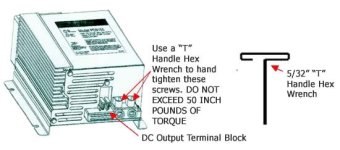Even the cheapest multimeters like the $5-$10 Amazon/Horror Fright specials can help you identify this if you know how. Most can't handle higher current flows so it's best to charge your battery fully as already mentioned above. So you charge your battery to 100%, then disconnect it and put the meter in "current" mode and follow its instructions (many require you to re-plug one lead in a different hole) you connect the meter between the battery and the disconnected cable.
Now go around your camper and turn on/off lights and other devices and see what they draw. Even things like the CO2 detector aren't hard to test - you usually just need to remove 2 screws so you can get access to disconnect the wiring temporarily. Make a table of all your "house loads" and what they draw.
If you prefer a more permanent (or just smarter) option you can get something like these:
https://www.amazon.com/Victron-SmartShunt-500AMP-Bluetooth-Battery/dp/B0856PHNLX ($100)
https://www.amazon.com/bayite-6-5-100V-Display-Multimeter-Voltmeter/dp/B013PKYILS ($16)
These permanently install between your battery and camper, usually on the negative terminal, and give you readouts and/or even Bluetooth monitoring of your draws.
Once you know all this you can determine two really important numbers:
1. Your "house load" - the load of everything in your camper whether you're using it or not. This is stuff like your CO2 detector, the OneTouch or similar if you have one, radios, etc.
2. Your "general usage" loads, which will vary, but you can usually work out typical scenarios, like "during the day I might not use much, but might have a light or two on" vs "from 6pm-10pm I probably have a bunch of lights on plus the radio".
Using these two numbers you can get two important "run time" / "capacity" numbers for your battery planning. Say you have 2x 100Ah lead-acid batteries. Now power = voltage * current so that's 2*100 * 12V or 2400 watt-hours of capacity. But with lead-acids, even deep-cycle aren't supposed to be discharged below 50% to maximize their lifetime, so let's say 1200Wh.
Now let's say your "house load" turns out to be 600mA, just hypothetically. Doesn't sound like much. And on a daily basis, it isn't. But that's 0.6*12 or 7.2W. If you're running your generator every day you're never going to notice this. However, if you put the camper in storage for a month without disconnecting the battery, suddenly that is 7.2W*24h/d*30d or 5184Wh consumed. Your batteries will be flat by the end of the first week! And now the math shows you why everyone almost unanimously recommends one of the following for campers going into storage:
1. Disconnect the batteries
2. Add a solar battery tender
Say your load with furnace, lights, your cell phone charging in one of those sofa USB ports, etc is about 8A on average. That's 96W. Now your batteries are only good for 12 hours. That's shorter than a lot of folks realize. If you are 100% full at 6pm you're going to be drained by 6am the next day! Now the math is telling you the answer to the question "do I need to buy a generator if I won't be on campground power?" Answer: Yes.
The final detail is: why bother converting everything to watts if we're just dividing by 12 at the end anyway? This is because (allowing for some efficiency losses) now you can change voltages and all the math still works. Solar panels usually run around 20V on average, but if we care about their "watts" we can say things like "100W of solar will more than cover my house loads, but aren't enough to charge my batteries very much".
I know I just went on a long-winded tangent here but the math is important because it answers literally everything. How much solar do you need;? How long will it take to charge my batteries on a generator? How long will my batteries last if I'm using/not using my camper? Etc.
The longevity is usually far less than most folks would hope.

